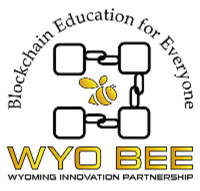By Mike Wilkins
Dr. Michelle Aldrich is the state career and technical education director for the Wyoming Department of Education. As part of her responsibilities, she’s acting as the co-principal for the Wyoming Innovation Project initiative to create a blockchain and digital asset curriculum at the high school and junior college level. In this role, she acts as a curriculum designer and instructional adviser, determining in her own words “what works and what doesn’t” for K-12 students throughout the course of this project.
DWN had the chance to sit down with Dr. Aldrich in early March to talk about her involvement in the project, and how she sees this cutting-edge technology focused platform taking shape.
DWN: Michelle, can you tell us about your role within the Wyoming DOE and the blockchain project?
MA: “Sure. I’m the state career and technical education director for the Wyoming Department of Education. I’m acting as co-principal investigator on their blockchain education project, working with Steve Lupien. Steve originally wrote the grant request from the Wyoming Innovation Project to create a curriculum around blockchain and digital assets for the high school and junior college level. Blockchain technology is becoming a significant part of Wyoming’s economy and thus there’s a need to educate our population. This young adult population needs to have familiarity with the technology, so they can secure jobs involving it.”
DWN: What types of faculty will be involved? Will there be blockchain specialist teachers?
MA: “There’s actually a nice mixture across multiple areas. For the blockchain, digital asset and fintech components of the curriculum, business and marketing teachers will be leading the way. Cybersecurity crosses over into computer science and math as well as the first two areas. We have a lot of people who are certified to teach business, marketing and computer science, but also a lot of computer science teachers who also teach math.”
DWN: What’s the curriculum look like?
MA: “That’s the million dollar question! We are just now starting to develop a framework. There’s going to be 12 learning modules, that’s the framework. There’s also going to be a graphic novel for the HS curriculum being created to help students to consume that material in a way that’s a little more user friendly for their grade level. One nearterm goal is to have the material at a level where high school students who complete it can get recognized concurrently for college credits.”
DWN: Is this course going to be an elective? Or mandatory?
MA: “When it comes to education, Wyoming is a local control state. It’s up to each district to decide what gets taught. That being said, for districts who receive Perkins grants (Federal government grants to states for secondary and post-secondary career and technical education), there needs to be a demonstration that the district is providing high-quality instruction that’s on a path toward an in-demand career area. So this curriculum is very attractive for all students, because it covers content that matches the high level of skills in demand for Wyoming’s future.”
DWN: So what appeals to you personally about blockchain? Is it something that resonates for all ages, but particularly for high school students?
MA: “Earlier in my career, I was a family consumer science teacher at an adult alternative school. I taught a lot about personal finance, life skills dealing with things like obtaining leases, IDs and birth certificates and professional licenses. The problem is for a lot of adults, especially in poorer areas the data they need for things like these is often hard to find or lost, so it’s hard for them to just obtain another copy. I was approached about putting all that information on-chain for students, but wasn’t sure of what to do.
In 2020, I attended a Bulls, Beers and Blockchain panel put on by the state prior to Frontier Days which really opened my eyes as to how the future of blockchain will be less complex and more and more of just a behind the scenes process for managing data to solve challenges like the ones I was seeing at the school. If we continue to prepare our students for 20th century jobs, we’re doing a disservice to the stakeholders in our communities, and to our state as we hope to diversify our economy. So many career and technology education programs are still very legacy focused – we need the latest and greatest technology and information to be competitive.
Wyoming is looking to move away from relying on mining, ag and tourism. We need to support things that are less sensitive and cyclical.”
DWN: Have you seen any skepticism or pushback from the population around teaching blockchain? If so, on what grounds?
MA: “For sure. There’s definitely a fear of the unknown, and that includes alternative financial systems. For a lot of people, it brings up memories or stories of the Great Depression and other financial crises, and the associated panics and bank runs. You have to remember, Wyoming has a population with a very independent streak and a lot of people don’t trust financial institutions or the government. Many older people still have money hidden under mattresses or buried in coffee cans in their yards. With Bitcoin, obviously it’s been in the news as a catalyst for dealing drugs and other illegal activities. People often don’t do their own homework on it and just assume the worst, so we need to change that.”
DWN: In your experience, what use cases for blockchain seem to resonate with you?
MA: “I see blockchain, and the associated digital currencies as a great equalizer. They help the unbanked to start saving, those with bad credit to improve their credit and get access to loans. The decentralization of finance is going to be so important, but we have to watch out for things that are seen as unknowns and educate the population on them. There’s such a wide audience we have to educate, but especially students’ parents. There’s a lot of ways we can do this, through things like interviews, podcasts, and social media. But the challenge is there’s so many news sources now and we have to figure out a way to cover them all.”
DWN: Last question. Thinking beyond just the educational initiative, and about the current climate as a whole, what makes Wyoming such an appealing place for technology talent?
MA: “The Wyoming quality of life is really hard for a lot of other states to compete with. Living here, you can leave your house after finishing work at 5, be on the golf course by 5:15, on the lake by 5:30, or up in the mountains by 5:45. Wyoming has no state income tax, and we’re a right to work state with a low crime rate. That’s really attractive to a lot of people in the current economic climate.”

We are proud to announce that Digital Wealth News, in conjunction with the American Crypto Academy, has partnered with the University of Wyoming Center for Blockchain & Digital Innovation to offer a 12-module course on blockchain for Wyoming’s high school juniors, seniors & community college studentes beginning with the Fall 2023 school year. The modules will also be available for a nominal licensing fee to other schools throughout the US.
Contact DWN’s publisher Cindy Taylor at cindy (at) dwealth (dot) news if you would like details on sponsoring this initiative or how you can help bring these modules to students in your community.
CLICK HERE FOR MORE INFO ON THIS DIRECTIVE
 Author Mike Wilkins is a capital markets industry veteran, with over 20 years experience in business development, product marketing and strategy roles. Mike has worked for enterprise firms and startups in Chicago, London and New York.
Author Mike Wilkins is a capital markets industry veteran, with over 20 years experience in business development, product marketing and strategy roles. Mike has worked for enterprise firms and startups in Chicago, London and New York.







